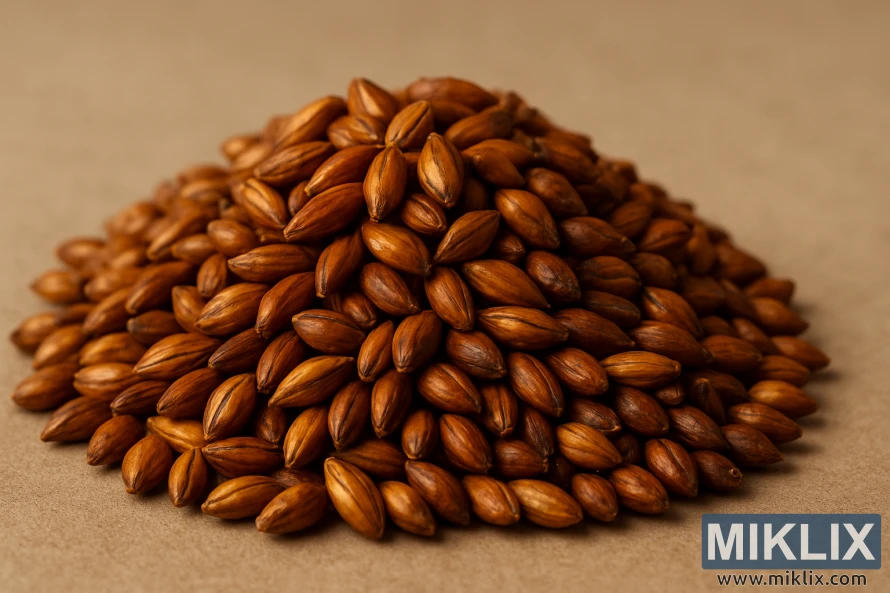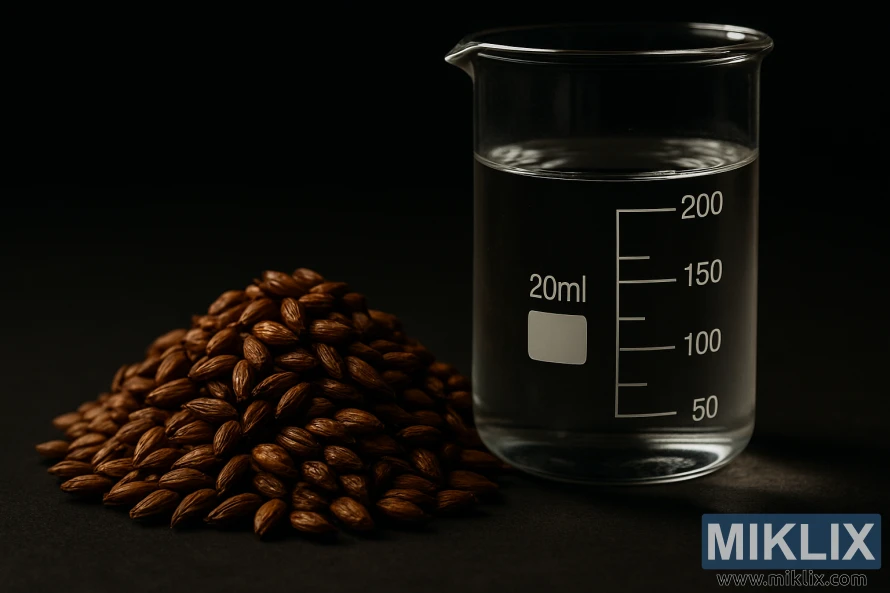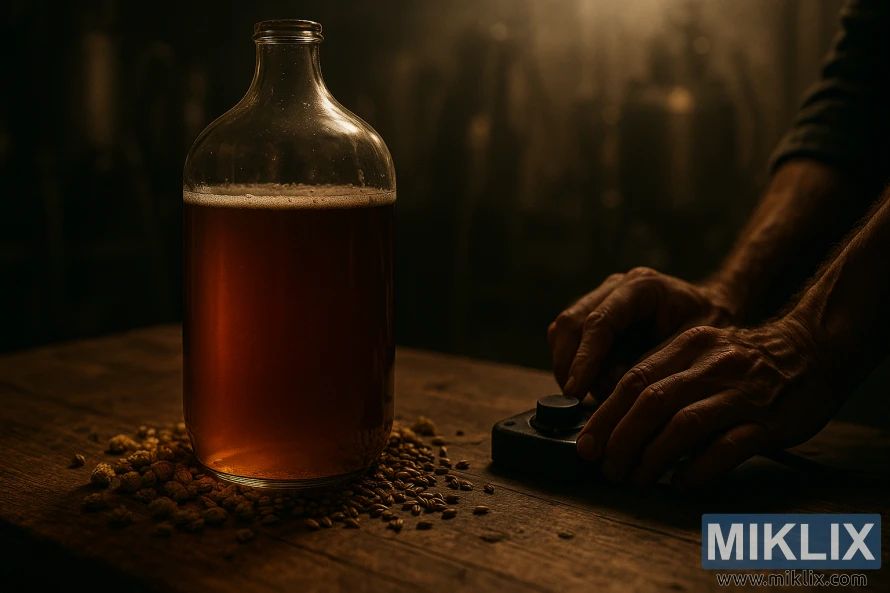Brewing Beer with Amber Malt
Published: August 6, 2025 at 5:01:05 PM UTC
Using specialty malts in brewing can significantly enhance your beer's flavor. Amber malt, in particular, brings out dry toast, nutty, and light coffee notes. This makes it a valuable addition to any brew. Expert brewers agree that roasted malts are key to complex flavors and aromas. Whether crafting an ESB or a Stout, amber malt can introduce depth and complexity. By mastering its use, you can brew unique and tasty beers.

Key Takeaways
- Amber malt adds dry toast, nutty, and light coffee flavors to beer.
- It is suitable for various beer styles, including ESB and Stout.
- Using amber malt can enhance the complexity of your brew.
- Understanding the characteristics of amber malt is essential for effective brewing.
- Experimenting with amber malt can lead to unique beer creations.
Understanding Amber Malt Characteristics
Amber malt's unique kilning process imbues it with a rich, toasted flavor, making it a staple in various beer styles. This malt type undergoes a specific kilning process to enhance its flavor and aroma. It is celebrated for its dry, toasted taste, with subtle nuttiness and a light coffee-like aroma.
The versatility of amber malt in brewing is unmatched. Its key attributes include:
- Dry toast flavor
- Slightly nutty undertones
- Light coffee-like aroma
- Contribution to beer's color and overall complexity
Amber malt is a go-to for adding both flavor and color to beer. Its kilning process boosts its natural sweetness, creating a distinct flavor profile. In brewing, it significantly influences the beer's taste and aroma.
To brew with amber malt effectively, one must grasp its characteristics and how it interacts with other ingredients. By harnessing amber malt's unique qualities, brewers can craft complex, flavorful beers that highlight its distinct attributes.
The History and Production of Amber Malt
For brewers aiming to craft exceptional beers, grasping the history and production of amber malt is key. Amber malt is celebrated for its dry toast, slightly nutty, and light coffee notes. Its rich history is deeply connected to the evolution of various beer styles.
The creation of amber malt involves several critical phases: malting, kilning, and roasting. Malting transforms grains into malt. This process starts with soaking grains in water to activate enzymes, allowing them to germinate. Then, they are dried in a kiln or with hot air to halt germination.
Kilning is a vital step that shapes the malt's flavor and color. For amber malt, kilning is fine-tuned to hit the perfect color and flavor mark. Roasting further refines the malt's traits, adding to its unique taste and aroma.
The history of amber malt production is inextricably linked to the advancement of brewing methods. Brewers have continually honed the malting and kilning techniques to ensure a consistent, premium product.
- Malting: The initial step where grains are soaked, germinated, and dried.
- Kilning: The process of drying the malt to stop germination and achieve the desired flavor and color.
- Roasting: Enhances the malt's flavor and aroma, contributing to its distinctive characteristics.
By delving into these processes, brewers can truly appreciate the artistry behind amber malt production. This understanding empowers them to use it more effectively in their recipes.
Essential Equipment for Brewing with Amber Malt
Brewing with amber malt requires specific equipment for achieving the perfect taste and quality. Homebrewers must first understand the basic brewing gear.
Key tools include a brew kettle for boiling, a fermenter for fermentation, and a mash tun for mashing grains. Each tool is essential for the brewing process.
- Brew kettle: For boiling the wort and hops.
- Fermenter: For fermentation, where yeast converts sugars into alcohol.
- Mash tun: For mashing grains, including amber malt, to extract fermentable sugars.
- Hydrometer: For measuring the gravity of the wort before and after fermentation.
- Siphon and racking cane: For transferring beer between vessels without disturbing the sediment.
When choosing equipment, consider material, size, and cleaning ease. A stainless steel brew kettle is durable and easy to clean. A food-grade plastic fermenter is lightweight and resistant to corrosion.
Knowing how to use this equipment is key. The mash tun must maintain a consistent temperature for optimal mashing. The fermenter should be kept at a stable temperature for the yeast strain.
Investing in the right equipment and understanding its use is vital. Homebrewers can then brew high-quality beers with amber malt. They will achieve complex flavors and aromas that this malt variety offers.
Selecting Quality Amber Malt for Your Brew
To brew exceptional beer, you must begin with superior ingredients, including top-notch amber malt. Amber malt is essential in many recipes, adding a rich, malty taste and a deep amber hue to the beer.
When choosing amber malt, several key factors come into play. The malt's quality is critical, as it directly influences the beer's taste. Opt for malt that is fresh, as old malt can introduce unwanted flavors to your brew.
The flavor profile of amber malt can differ between manufacturers. Some may offer a more pronounced nutty or toasted taste, while others provide a cleaner, more subtle malt flavor. It's vital to select an amber malt that matches your beer's style and desired taste.
- Check the malt's specifications and certifications.
- Consider the malt's origin and production methods.
- Read reviews and ask for recommendations from other brewers.
By carefully choosing high-quality amber malt, you can guarantee your beer's best flavor and character. This focus on detail in brewing can significantly enhance your final product's quality.

Proper Storage and Handling of Amber Malt
Preserving the flavor and aroma of amber malt requires proper storage. This ingredient is sensitive and can degrade if not stored correctly.
It's vital to store amber malt in a cool, dry place. This means avoiding direct sunlight, moisture, and heat sources. A cool, dry environment is key to maintaining the malt's flavor and aroma, keeping it fresh for longer.
- Keep it in an airtight container to prevent moisture absorption.
- Store it in a cool, dry place, away from direct sunlight.
- Avoid storing it near heating vents or ovens.
- Use it within a reasonable timeframe to ensure freshness.
By adhering to these storage and handling tips, brewers can keep their amber malt fresh and effective. This ensures a better-tasting final product. Proper storage is a simple yet critical step in brewing that greatly impacts beer quality.
Recipe Development with Amber Malt
Creating a recipe with amber malt demands a thorough grasp of its flavor profile and its interaction with other ingredients. Amber malt introduces a dry toast and slightly nutty taste to beers. This makes it a versatile ingredient for a wide range of beer styles.
Brewers must consider the beer style they aim to create and how amber malt will enhance its character. For instance, in a malty amber ale, amber malt boosts the maltiness and adds depth. In a porter, it brings complexity with its dry toast and light coffee notes.
The dry toast and nutty flavors of amber malt are perfect for various beer styles. To balance these flavors, brewers can adjust the amount of hops and other malts. For example, combining amber malt with a light Munich malt like Lighthouse Munich Malt can introduce a clean, bready flavor.
To craft a unique recipe, brewers should experiment with different proportions of amber malt and other ingredients. Here are some tips for recipe development:
- Start by determining the style of beer you want to brew and the role you want amber malt to play in it.
- Experiment with different ratios of amber malt to other malts to achieve the desired flavor profile.
- Consider the hopping strategy and how it will balance with the flavors contributed by the amber malt.
- Don't be afraid to try new combinations of ingredients and brewing techniques to create a unique beer.

Mashing Techniques for Amber Malt Beers
Amber malt demands precise attention during mashing to reveal its distinctive dry toast and nutty notes. Mashing extracts sugars from malt, which are then fermented to craft beer. The mashing technique significantly influences the beer's flavor and quality.
To enhance the mashing process for amber malt, brewers must focus on several critical aspects. These include the mash temperature, the water-to-malt ratio, and the mash duration. Here are essential steps and considerations for effective mashing with amber malt:
- Opt for the right mash temperature. For amber malt, a temperature between 152°F and 155°F is recommended. This range balances fermentable and non-fermentable sugars.
- Choose an appropriate water-to-malt ratio. A high ratio can result in a watery beer, while a low ratio may cause a stuck mash.
- Consider the mash pH. Amber malt can introduce a slightly acidic pH. This might necessitate adjustments to ensure optimal enzymatic activity.
The mashing process includes several phases, such as doughing in and sparging. Doughing in involves mixing malt with hot water, while sparging uses hot water to extract sugars. The details of these steps can differ based on equipment and desired beer characteristics.
- Dough in the malt at a temperature around 160°F to 165°F to help gelatinize the starches.
- Allow the mash to rest for a period, typically around 60 minutes, to enable enzymatic conversion of starches to sugars.
- Sparge with enough hot water to achieve the desired pre-boil volume, taking care not to over-sparge, which can extract unwanted tannins.
By meticulously controlling the mashing process, brewers can fully exploit amber malt's flavor. Whether brewing a traditional amber ale or exploring new recipes, mastering effective mashing techniques is key to achieving superior results.
Water Chemistry Adjustments for Amber Malt Brewing
To brew great beer with amber malt, adjusting your water chemistry is key. Water chemistry significantly impacts the beer's flavor and character. For amber malt, achieving the right mineral balance and pH levels is essential. This ensures the beer showcases dry toast, slightly nutty, and light coffee flavors.
Understanding your brewing water's mineral profile is the first step. You need to consider calcium, magnesium, sodium, chloride, sulfate, and bicarbonate. Each mineral has a role in brewing and affects the beer's final taste.
- Calcium: Important for enzyme activity and stability.
- Magnesium: Essential for yeast health and fermentation.
- Sulfate: Contributes to the dryness and bitterness of the beer.
- Chloride: Enhances the body and sweetness of the beer.
Optimizing the pH level is also vital. The ideal mash pH for brewing with amber malt is between 5.2 and 5.4. Proper water chemistry adjustments will help achieve this optimal range. This ensures the best possible extraction of flavors from the amber malt.

Fermentation Considerations and Yeast Selection
Amber malt beers require a careful approach to fermentation, beginning with the selection of the right yeast strain. The chosen yeast strain can greatly impact the beer's flavor, aroma, and overall character.
Fermentation is a critical step in brewing, and amber malt presents specific considerations. According to brewing principles, "Yeast is responsible for fermenting the sugars in the wort, producing alcohol and carbon dioxide."
When choosing a yeast strain for amber malt beers, brewers must consider several factors. These include the yeast's attenuation level, flocculation characteristics, and temperature range. Here are some key considerations:
- Choose a yeast strain that complements the flavor profile of amber malt, such as those that enhance malty or slightly nutty flavors.
- Consider the yeast's attenuation level to ensure it aligns with the desired beer style and gravity.
- Opt for a yeast with suitable flocculation characteristics to achieve the desired clarity and stability in the finished beer.
Optimizing fermentation conditions is also critical. This involves maintaining the right temperature, ensuring adequate nutrient supply, and monitoring fermentation progress.
- Temperature control is vital; most ale yeasts used for amber malt beers ferment best between 65°F to 75°F (18°C to 24°C).
- Adequate nutrients are necessary for healthy yeast growth and fermentation.
- Regular monitoring of fermentation progress helps in identifying any issues early on.
By carefully selecting the right yeast strain and optimizing fermentation conditions, brewers can produce high-quality amber malt beers. These beers showcase the unique characteristics of this malt type.
Common Brewing Challenges with Amber Malt
Amber malt, while versatile, presents unique brewing challenges that need to be addressed. One of the primary concerns when brewing with amber malt is the risk of over-extraction. This can result in an unbalanced flavor profile.
Over-extraction happens when too many compounds are pulled from the malt. This leads to a beer that tastes bitter or astringent. To avoid this, brewers must pay close attention to their mashing techniques. They should also adjust their sparging processes.
Astringency is another common issue with amber malt. It's caused by the extraction of tannins during brewing. To reduce astringency, brewers can tweak their water chemistry. They should also ensure their mash pH is within the optimal range.
Troubleshooting these common brewing challenges requires a deep understanding of the brewing process. It also demands knowledge of amber malt's characteristics. By being aware of these issues, brewers can take preventive measures. This way, they can produce high-quality beers.
- Monitor mashing temperatures to avoid over-extraction.
- Adjust sparging techniques to minimize tannin extraction.
- Ensure optimal water chemistry to prevent astringency.

Popular Beer Styles Using Amber Malt
Brewing with amber malt opens a world of possibilities for craft beers. This versatile ingredient enhances flavor and complexity in various beer styles.
Amber malt is commonly used in several popular beer styles, including:
- Pale Ales: Amber malt adds a rich, malty flavor to pale ales, balancing out the hoppy notes.
- IPAs: The malty sweetness of amber malt complements the bitterness of hops in IPAs, creating a well-rounded flavor profile.
- Stouts: Amber malt contributes to the complexity of stouts, adding layers of flavor that enhance the overall drinking experience.
- Amber Ales: As the name suggests, amber ales often feature amber malt as a primary ingredient, showing its warm, malty characteristics.
- Bocks: Amber malt can be used in bock recipes to add depth and a rich, malty flavor.
These beer styles showcase amber malt's versatility in brewing. By using amber malt, brewers can craft complex and flavorful beers that appeal to many palates.
When experimenting with amber malt in different beer styles, brewers should consider its interaction with other ingredients. Amber malt's dry toast, slightly nutty, and light coffee notes make it a valuable addition to many recipes.
Quality Assessment and Tasting Notes
Evaluating your amber malt beer's quality requires a detailed look at its flavor, aroma, and overall character. A top-notch amber malt beer should have a balanced mix of malt sweetness and hop bitterness. It should also have a rich, malty taste.
When evaluating your beer's quality, consider several factors:
- Flavor profile: Aim for a balanced taste with hints of toasted malt, nuts, or caramel.
- Aroma: A quality amber malt beer should have a malty, slightly sweet scent.
- Appearance: The beer's color and clarity can show its quality.
Tasting notes are key to improving your brewing. Record your observations, including the beer's strength, balance, and drinkability. For example, Lighthouse Munich Malt is known for its clean, bready flavor. This can be a useful reference.
By regularly assessing your beer's quality and taking detailed tasting notes, you can pinpoint areas for improvement. This will help you refine your brewing skills.
Troubleshooting Your Amber Malt Brew
Troubleshooting is key when brewing with amber malt to tackle common problems like over-extraction and astringency. Brewers often face several challenges that can impact their beer's quality. These issues can arise from various factors during the brewing process.
Common problems include over-extraction, which can make the beer taste bitter, and astringency, causing a dry, puckering sensation. To tackle these, brewers can tweak their mashing techniques and adjust the water chemistry.
- Check your mashing temperature and adjust as necessary to avoid over-extraction.
- Monitor your water chemistry and make adjustments to prevent astringency.
- Verify that your equipment is clean and sanitized to prevent contamination.
- Consider using a different yeast strain or adjusting your fermentation temperature to improve fermentation consistency.
By following these steps, brewers can identify and resolve common issues associated with brewing with amber malt. This results in a higher quality beer.
Some additional considerations include:
- Ensuring the quality of the amber malt by checking its freshness and storage conditions.
- Adjusting the brewing process based on the specific characteristics of the amber malt being used.
- Keeping detailed records of the brewing process to identify patterns and areas for improvement.
Conclusion
Brewing beer with amber malt is a complex process that can enhance your creations with its rich, complex flavors. Understanding the characteristics, history, and production of amber malt is key to achieving the desired taste in your brews.
The unique dry toast, slightly nutty, and light coffee notes that amber malt adds to your beer are perfect for various styles, from ESB to Stout. By choosing quality amber malt, following proper storage and handling, and experimenting with different recipes and mashing techniques, you can unlock a world of flavors.
Whether you're an experienced brewer or just starting, incorporating amber malt into your brewing can be rewarding. With the right equipment, water chemistry adjustments, and yeast selection, you can create beers that showcase amber malt's full range. As you continue to experiment and refine your craft, you'll discover the many possibilities that amber malt offers in brewing beer, bringing your conclusion to a successful brew.
Further Reading
If you enjoyed this post, you may also like these suggestions:
- Brewing Beer with Dehusked Carafa Malt
- Brewing Beer with Melanoidin Malt
- Brewing Beer with Mild Ale Malt
